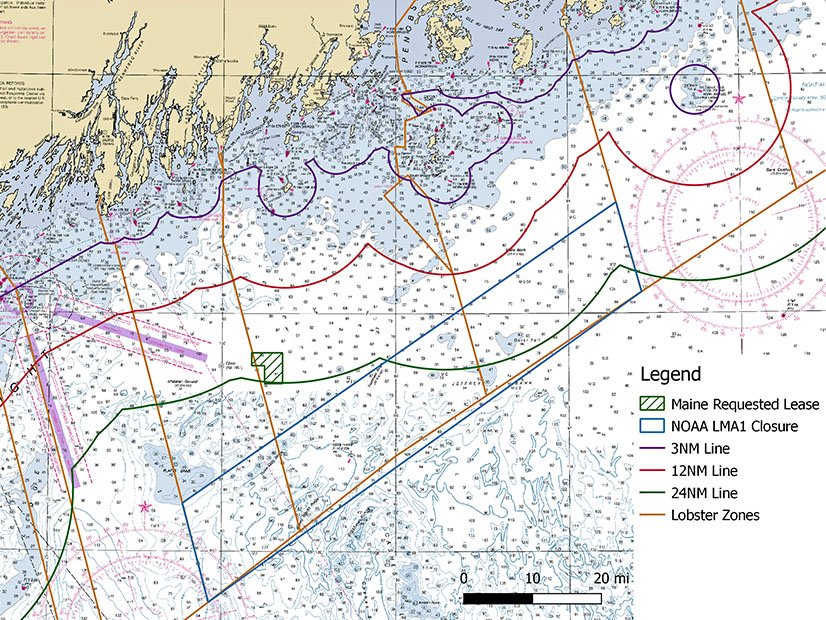
Maine Gov. Janet Mills on Monday vetoed legislation to streamline the permitting of ports to serve the offshore wind industry she and many others hope to develop in the Gulf of Maine.
Mills herself had originally proposed the bill to standardize evaluation of offshore wind port proposals and dubbed it “An Act to Modify the Visual Impact Standards for Offshore Wind Port Development.” (LD 1847.)
The Legislature amended it to include several progressive priorities, including requirements for project labor agreements for building the port and then for work done there; labor peace agreements; workforce diversity and equity plans; just transition and workforce development plans; and the use wherever possible of zero-emissions port equipment and technology.
They aptly renamed the amended measure “An Act to Modify the Visual Impact Standards for Offshore Wind Port Development and Establish Labor Standards for Wind Power Projects.”
Mills objected to the labor provisions of the Legislature’s amended bill. Last week she asked legislators to remove the language or to add additional language that would ensure employee-owned business and small businesses would benefit as well as union workers. They did not.
In her veto message Monday, she told legislators:
“Harnessing the benefits of offshore wind will require an ‘all-hands-on-deck’ approach that includes unions, small businesses and existing employee-owned and other Maine companies. Without that approach, Maine will be at a disadvantage compared to other New England states. It is imperative that investment in offshore wind facilities and projects foster opportunities for Maine’s workforce and construction companies to compete on a level playing field for this work.”
Mills said in the veto message that she wanted to work with the Legislature on LD 1847 and on LD 1895, another offshore wind measure that contains provisions unacceptable to her. She said she sees some willingness to do this among the measures’ sponsors.
In the June 21 letter to the sponsors, Mills said she recognizes “the value of PLAs, or collective bargaining agreements, as a tool to lift up working men and women by ensuring that they are paid strong wages with good benefits.”
But she had three specific objections to requiring them in this instance:
-
- More than 90% of Maine’s construction workers are non-union.
- Construction costs are soaring, and a PLA would further increase prices that ultimately would be borne by Maine ratepayers.
- No other New England state imposes a statutory requirement for PLAs on offshore wind projects. Rather, state and federal regulations and solicitations typically “encourage” PLAs, which she would not object to.
Organized labor was not happy with Mills’ position.
“You can’t create the jobs of tomorrow with yesterday’s wages & labor standards,” tweeted the Maine AFL-CIO, which endorsed Mills for re-election in 2022.
Executive Director Matt Schlobohm said in a Facebook post: “Maine’s climate motto has been ‘Maine Won’t Wait.’ With this veto, Gov. Mills is saying, ‘Maine Will Wait’ — for thousands of good jobs, for clean energy & for the build out of a new industry. We will wait because the Governor is opposed to fair labor standards which are the industry norm.”
Mills is a Democrat, as are the majorities of both houses of the Legislature, and organized labor is a core constituency of the Democratic Party.
As President Biden signed the landmark Inflation Reduction Act of 2022 — enacting a welter of transformational clean-energy tax credits and subsidies — the White House emphasized that it would create good-paying union jobs nationwide by incentivizing prevailing wage agreements and apprenticeship programs.
Maine’s Situation
The U.S. Bureau of Labor Statistics reports that 9.2% of workers in Maine were union members in 2022, compared with 10.1% nationwide.
The percentage is much higher in other Northeast states that are trying to build an offshore wind industry: 12.7% in Massachusetts, 14.2% in Connecticut, 14.9% in New Jersey, 16.1% in Rhode Island and 20.7% in New York, the second highest in the nation.
Maine has some obstacles to its offshore wind ambitions that the other states do not.
For starters, the other states are developing wind power with turbines whose foundations are fixed to the ocean floor, a model used for decades worldwide. The Gulf of Maine is too deep for this — any turbine array there will need to float, and floating technology is still in its early stages, with limited commercial build-out as research and development continue.
But Maine is seeking a lease from the U.S. Bureau of Ocean Energy Management to site a floating research array generating up to 144 MW, and the University of Maine has a long-running effort to position itself as a center of U.S. floating wind research.
There also is the question of where to put the ports that would (or would not) need to employ union labor. As in other states, there is strong local opposition to industrializing the coast and ocean, which along with forests are central to Maine’s identity.
But most of Maine’s long, rocky coast is unsuitable to be a homeport for hulking installation vessels.
Sears Island on the central coast has emerged as a candidate. It is one of the largest accessible undeveloped islands on the Eastern Seaboard, and over the past few decades, one proposal after another — nuclear reactor, LNG terminal, coal power plant, oil refinery, container port — has died in the face of local opposition.
There is an Irving oil terminal a few hundred yards away on the mainland, but aside from that it remains a wooded nature preserve in a region dotted with quaint villages and small harbors. Advocates want to keep it that way.
At a meeting of the Maine Offshore Wind Port Advisory Group on Monday, multiple speakers voiced opposition to the concept of building a port there, some vowing a fight if one was proposed.



